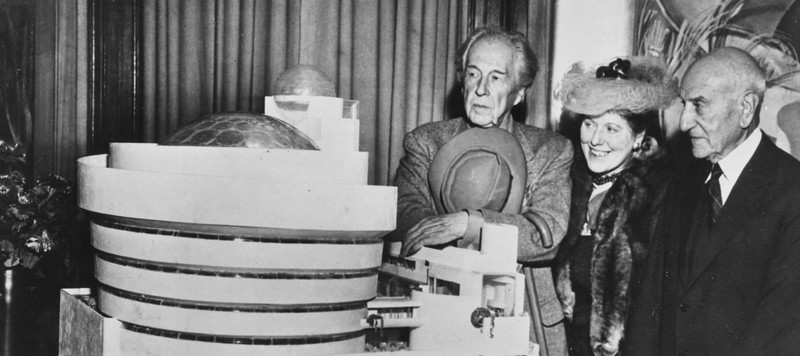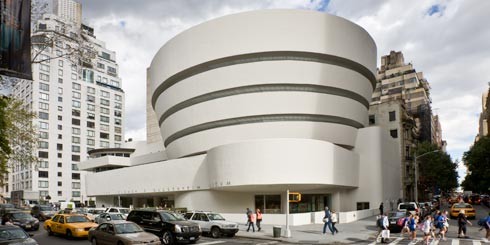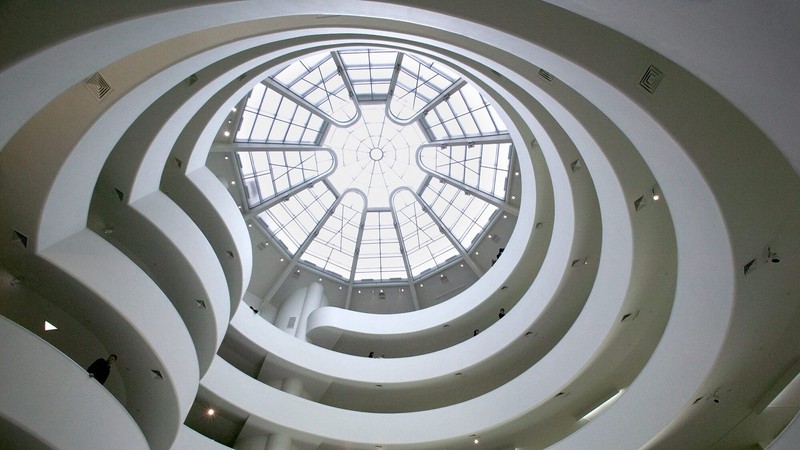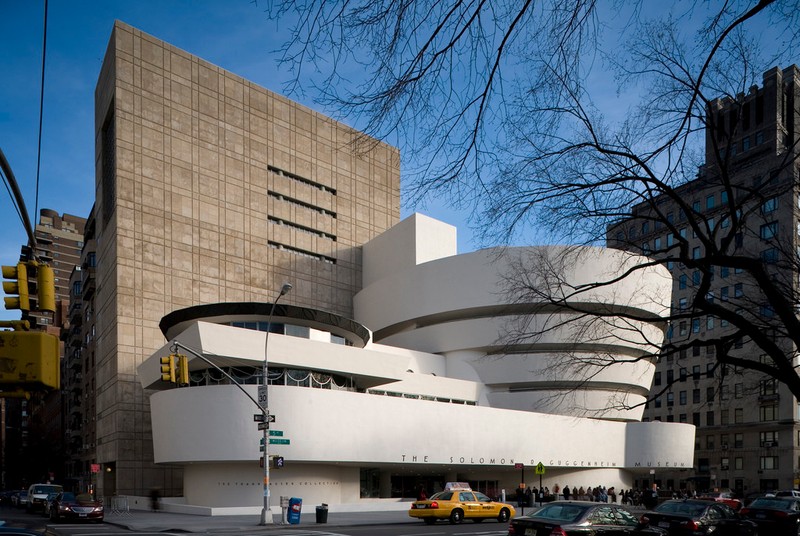Solomon R. Guggenheim Museum
Introduction
Text-to-speech Audio
Images
From left to right; Frank Lloyd Wright, Hilla Rebay, and Solomon R. Guggenheim stand with a model of the Guggenheim Museum. Photo taken 1945.

Architectural cross-section of the museum.
.jpg)
Exterior of the Guggenheim Museum.

A view from the rotunda upwards.

Alternate view of the museum. Note the 1992 addition in the background.

Backstory and Context
Text-to-speech Audio
Now one of the most significant modern and contemporary art museums in the world, the Solomon R. Guggenheim Museum has relatively humble origins. Solomon R. Guggenheim was a member of a wealthy Swiss family that made its fortune investing in American mining during the Gold Rush. Guggenheim attended school in Zurich, Germany before marrying Irene Rothschild. Together, the couple began collecting art by old masters in the 1890s. In 1926, a momentous meeting altered the course of Guggenheim’s interests. Hilla von Rebay was a German abstract artist who became acquainted with Guggenheim and Rothschild when she was commissioned to paint the latter’s portrait. The three art appreciators later travelled to Europe together, where Rebay kindled a love of non-objective art in Guggenheim. Guggenheim began purchasing works by European avant-garde artists such as Vasily Kandinsky, Marc Chagall, and Fernand Léger. In 1930, Guggenheim allowed the public to view his art collection housed in his apartment in the New York Plaza Hotel. Sensing a need for a more formal approach to his goals and interests, Guggenheim established the Solomon R. Guggenheim Foundation in 1937.
The Solomon R. Guggenheim Foundation hosted its first official exhibition in 1939 and was known as the Museum of Non-Objective Painting. Non-Objective art refers specifically to a style of European art that emerged in the 1910s and 1920s. Non-Objective art tends to use shapes as the primary art elements and Non-Objective works do not correspond to anything that actually exists. This is in contrast to abstract art which uses abstraction to correspond with things that may exist. The Guggenheim Foundation’s exhibitions were some of the first opportunities to experience Non-Objective art for many Americans. As the foundation’s collection grew, so did its popularity. By the early 1940s, there was already a pressing need for a permanent exhibition space. Many architects were considered to design a museum for the foundation, but in 1943, Rebay and Guggenheim wrote a personal appeal to architect Frank Lloyd Wright.
Wright was not an obvious choice to design the Guggenheim Foundation’s new museum. Though the architect was internationally renowned, his reputation came from his residential designs which integrated seamlessly with the natural world. Furthermore, Wright had little experience with the constraints of urban planning and had never designed a museum before. Despite these challenges, Wright passionately took to the task of creating the museum building. Due to changing plans, budgetary limitations, modification of designs, and creative clashes, the structure was not completed until 1959 – sixteen years after Wright was initially contracted. The completed building resembles a coiled spring rising to a monumental glass oculus. The interior of the structure is centered around the atrium under the glass oculus, with a gently sloping walkway continuously climbing skyward around the edges. Artwork is displayed directly on the walls of this walkway, and in rooms that radiate from the central rotunda. Sadly, neither Guggenheim nor Wright lived to see the completion of the museum. Guggenheim died in 1949 and the museum was renamed to the Solomon R. Guggenheim Museum in his memory. Wright died in 1959, just months before the museum opened.
When the Guggenheim Museum opened in 1959, it garnered extreme reactions from the art world, the media, and the general public. While some lauded the museum as a triumph of engineering, others found the structure to be tastelessly distracting from the art. No commenter, however, could deny that Wright’s building was revolutionary. Until that point, museums had predominantly been historically grand – like the Louvre or Metropolitan Museums – or neutral and unassuming. The curvilinear forms and bright white exterior of the Guggenheim Museum caused it to stand out from its neighboring blocky stone buildings. On the interior, the curving walls were intended to force the art to be tilted backwards as if it were on an easel. Wright created a statement that blurred the lines between art and vessel. The legacy established by the Guggenheim Museum reverberates even today in the designs of other modern and contemporary art museums.
The Guggenheim Museum expanded in 1992, when Gwathmey Siegel & Associates Architects realized an additional Wright design. Wright had intended for a ten-story tower to be erected on the property, but the plan was scrapped due to financial reasons. While remaining as true to Wright’s drawings as possible, Gwathmey Siegel & Associates Architects created an eight-story rectilinear gridded tower. The simple design helps complement the main building, while avoiding distraction from the architectural centerpiece. The exterior of the Guggenheim Museum building was repaired and conserved from 2005-2008. The museum building was also recognized in several ways in the twenty-first century. In 2008, it was added to the National Register of Historic Places, and in 2015, it was nominated to the UNESCO World Heritage List. The Guggenheim Museum continues to welcome visitors to see its extensive collections of modern and contemporary art in an architecturally vibrant setting.
Sources
About Us. Guggenheim. Accessed 4/22/17. https://www.guggenheim.org/about-us.
The Architecture Of The Solomon R. Guggenheim Museum. Architecture List. 6/22/12. Accessed 4/22/17. http://www.architecturelist.com/2012/06/22/the-architecture-of-the-solomon-r-guggenheim-museum/.
Art of Tomorrow: Hilla Rebay and Solomon R. Guggenheim, Guggenheim Museum. Accessed October 14th 2020. http://pastexhibitions.guggenheim.org/hilla_rebay/biographies_2.html.
LaFrank, Kathleen. Solomon R. Guggenheim Museum, National Register of Historic Places. January 1st 2005. Accessed October 14th 2020. https://s3.amazonaws.com/NARAprodstorage/lz/electronic-records/rg-079/NPS_NY/05000443.pdf.
Perez, Adelyn. AD Classic: Solomon R. Guggenheim Museum / Frank Lloyd Wright, Arch Daily. Accessed October 14th 2020. https://www.archdaily.com/60392/ad-classics-solomon-r-guggenheim-museum-frank-lloyd-wright.
Pfeiffer, Bruce Brooks. The Solomon R. Guggenheim Museum. Edition 2nd. New York, NY. Guggenheim Museum Pubns, 1996.
Solomon R. Guggenheim Museum, Frank Lloyd Wright Foundation. Accessed October 14th 2020. https://franklloydwright.org/site/solomon-r-guggenheim-museum/.
Solomon R. Guggenheim Museum, NYC Arts. Accessed October 14th 2020. https://www.nyc-arts.org/organizations/139/solomon-r-guggenheim-museum.
Greenhaus, Donald. 1945. Frank Lloyd Wright Foundation. Accessed October 14, 2020. https://franklloydwright.org/concerning-the-solomon-r-guggenheim-museum/.
Arch Daily. Accessed October 14, 2020. https://www.archdaily.com/60392/ad-classics-solomon-r-guggenheim-museum-frank-lloyd-wright/5037de5128ba0d599b0000bc-ad-classics-solomon-r-guggenheim-museum-frank-lloyd-wright-image.
"Solomon R. Guggenheim Museum." NYC Arts. Accessed October 14, 2020. https://www.nyc-arts.org/organizations/139/solomon-r-guggenheim-museum.
Ray, Markus. "Frank Lloyd Wright - Guggenheim." Markus Ray's 'Art Look.' Accessed October 14, 2020. https://markusray.com/architecture/frank-lloyd-wright-guggenheim/.
Arch Daily. Accessed October 14, 2020. https://www.archdaily.com/60392/ad-classics-solomon-r-guggenheim-museum-frank-lloyd-wright/5037de5128ba0d599b0000bc-ad-classics-solomon-r-guggenheim-museum-frank-lloyd-wright-image.
